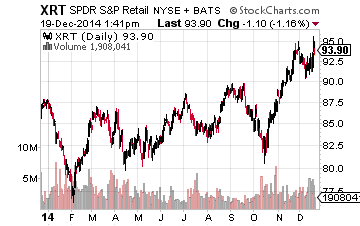The Winners Of Low Oil Prices
Falling oil prices have been making all the news, but what are the positives for American consumers?
Although oil prices began to decline in early August, the drop became more significant after September 30th. The Thanksgiving Day decision by OPEC oil ministers to leave the organization’s oil production quota unchanged at 30 million barrels per day triggered a more dramatic sell-off. The price of West Texas Intermediate Crude had dropped below $70 per barrel at that point. When oil prices are below $80 per barrel, shale oil extraction becomes unprofitable. Most energy sector commentators agree that OPEC is driving down oil prices to destroy competition from the shale oil boom.
The first stocks which respond favorably to a drop in oil prices are usually airline stocks. In this situation, the airline stocks began gaining altitude in mid-October. The Dow Jones Transportation Index began a string of almost-daily, new record intraday highs in early November, which continued through the first week of December.
During that time, the iShares Dow Jones Transportation Average Index ETF (IYT) followed a similar course. Unlike the airlines, the broader transportation sector began to suffer because oil shipments account for a good deal of rail traffic. Beyond that, stocks for tank car manufacturers began to sink.
Overall, the biggest beneficiaries of lower oil prices should be us, American consumers, as we’re forecast to be able to save 25 percent at the gas pump. As a result, consumers should have more money to spend on other items. Because the American economy is 70-percent consumer driven, we could see demand for products and services soar. A number of economists have compared the slump in oil prices to such things as a stimulus check from the government to the American consumer or a generous income tax rebate.
As consumers spend more, consumer-oriented stocks and ETFs could make some nice gains. Although the recent stock market pullback, which ran from December 8 through December 16, took its toll across all market sectors, a two-day rebound restored most of those declines.
 The SPDR S&P Retail Index ETF (XRT) has already climbed above its highs from before this month’s stock market pullback. Between November 4 and December 18, XRT climbed 7.96 percent to an all-time high of $95 per share. Similarly, the Market Vectors Retail ETF (RTH) closed at its own all-time high of $70.95 per share on December 18, after soaring 9.74 percent since November 4.
The SPDR S&P Retail Index ETF (XRT) has already climbed above its highs from before this month’s stock market pullback. Between November 4 and December 18, XRT climbed 7.96 percent to an all-time high of $95 per share. Similarly, the Market Vectors Retail ETF (RTH) closed at its own all-time high of $70.95 per share on December 18, after soaring 9.74 percent since November 4.
The Consumer Discretionary Sector SPDR ETF (XLY) gained 5.48 percent between November 4 and December 5. The closing price for XLY on December 18 was just 0.78 percent shy of its closing price of $71.53 on December 5. The holdings of XLY go beyond the retail sector and include a number of businesses which are not likely to show as rapid a response to consumer spending as we see with retail. Some of these businesses include cable television providers, such as Comcast (CMCSA) and Time Warner (TWX), as well as movie production companies, such as Twenty-First Century Fox (FOX), and Walt Disney (DIS) . Over time, we could see a stronger advance by XLY.
While many analysts are warning that oil prices could drop to $40 per barrel, we could see more excitement in the retail and consumer discretionary sectors should that occur.
Disclosure: None.



